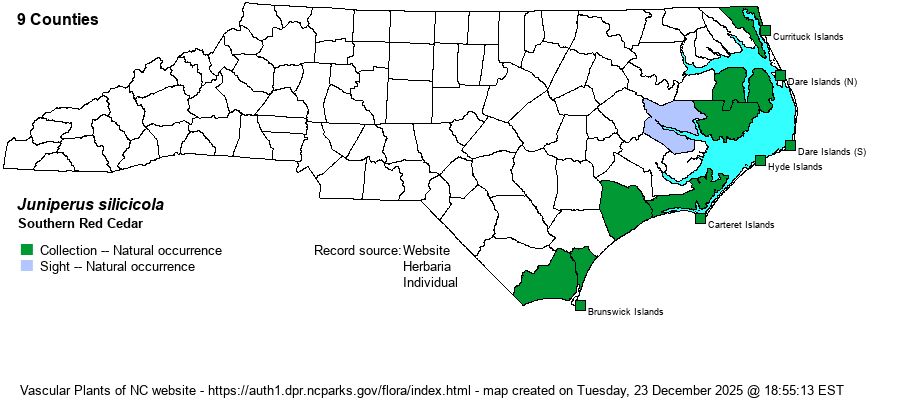| Author | (Small) L.H. Bailey | |
| Distribution | Occurs along the entire coast and along the mainland sides of sounds and bays, not extending inland away from tidal waters.
This coastal species ranges north only to southeastern VA, and south to southern FL, and around the Gulf Coast to LA. | |
| Abundance | Common along essentially all of the coast, such as on barrier islands. Less numerous on the mainland, always close to salt or brackish waters. The NC NHP rank of S2? is much too "rare", and thus the website editors have recommended a State Rank of S4. | |
| Habitat | This species has a variety of coastal habitats: maritime forests and thickets, dunes, edges of tidal marshes, and shell middens. Thus, it occurs in many if not most natural habitats on barrier islands. |
| Phenology | Pollen is released in January and February, but ripe fruit are not present until October and November. | |
| Identification | This is a small evergreen tree, often just 10-15 feet tall, but it can rarely reach about 50 feet tall. It is best separated from the very closely related -- and often considered conspecific -- Eastern Red Cedar (J. virginiana); however, Southern Red Cedar has a somewhat rounded to flat-topped crown, and the lower branches tend to droop, often very close to the ground. The latter and more inland species has the familiar cone-shaped form with an acute, spire tip; most branches tend to be ascending, including lower branches. Weakley (2020) adds these differences: silicicola -- "Female cones ("berries") 3-4 mm long; male cones 4-5 mm long; terminal twigs 0.75-0.90 mm wide (including the scale-like leaves); scale leaves 1.20-1.45 mm long, obtuse to acute", whereas virginiana -- "Female cones ("berries") 4-7 mm long; male cones 3-4 mm long; terminal twigs 0.85-1.00 mm wide (including the scale-like leaves); scale leaves 1.40-1.65 mm long, acute". As a general and quick rule, you should be able to identify it by its rounded form and coastal habitats. Eastern Red Cedar can occur close to the coast, but only as planted or escaped individuals. In addition, the uncommon Atlantic White Cedar (Chamaecyparis thyoides) can occur near the coast, such as at Alligator River National Wildlife Refuge. This tree is usually taller, has a rather spire shape like Eastern Red Cedar, though shaggy-looking, and the branches have flattened "sprays" of twigs and needles (in a single plane), as opposed to sprays of vegetation that are not flattened in the Juniperus species. | |
| Taxonomic Comments | References seem to be evenly split as to whether they consider this as a good species, or as a variety of Eastern Red Cedar -- as J. virginiana var. salicicola. This indecision has been present for many decades and there seems to be no obvious trend; our website follows Weakley (2018). For an alternate view, see Krings (2010). More recently Adams and Schwartzbach (2012) did DNA analyses in which J. salicicola was intermediate between virginiana and barbadensis of the Caribbean and Bahamas. This genetic intermediacy suggests ancient contact between the two parents.
| |
| Other Common Name(s) | None, other than phrasing of "red cedar", such as Southern Redcedar or Southern Red-cedar. | |
| State Rank | S2? [S4] | |
| Global Rank | G5T4T5 [G4G5] | |
| State Status | | |
| US Status | | |
| USACE-agcp | | |
| USACE-emp | | |

